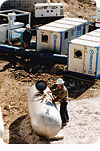
All construction materials inside the structure absorb moisture, including wallboard, fireproofing, lumber, block, and concrete. Unless that moisture is reduced to acceptable tolerances, the condition can delay the construction timetable, cause performance failure of some material, or lead to the formation of mold.
Surfaces often include freshly sprayed fireproofing, joint compound, concrete slabs, floor leveling products, concrete block walls, and stored building materials. Water-laden fireproofing and joint compounds dry slowly inside closed areas when applied. Often, the humidity that results can encourage mold contamination. Finished flooring products such as vinyl composite tile and fiber-backed carpet are applied with adhesives extremely sensitive to moisture. Without proper drying, large amounts of water can be trapped in concrete, preventing the installation of flooring.
Contractors generally use direct-fired heaters or desiccant dehumidification systems to accomplish drying during the construction of commercial, industrial, and high-rise residential buildings.
Some contractors also attempt to dry by using the HVAC system, but that has been proven highly ineffective. HVAC systems are engineered for temperature control and not moisture removal capacity. Running the blowers can spread dust and mold spores throughout the ventilation system and even cause damage to the HVAC equipment, coils, or filters. Also, using HVAC prior to commissioning the building can lead to warranty issues and concerns. Because of these reasons, some building owners no longer allow the use of the HVAC system during construction.
PROPER DRYING DEFINED
Proper drying is a key factor. Principles of physics dictate that simply introducing heat into a building space is not an effective method to dry the air. Conventional HVAC systems are not designed to dry out construction-related moisture. The moisture load from wet materials is simply too large and the drying task too complex for systems that are intended for comfort.In uncontrolled atmospheric conditions, water molecules that exist in the air exert vapor pressure on the materials of which it comes into contact. The warmer the air, the more water vapor is present.
Permeable materials - that includes almost everything inside a building - absorb water vapor to differing degrees. Unabated, that process will continue to the point that equilibrium moisture content (EMC) is reached, when the material neither gives up nor takes on moisture from the surrounding air. By lowering the vapor pressure between the material and the ambient conditions around it, the material will begin to give up moisture.
Moisture will travel from areas of high vapor pressure within the material to the areas of lower vapor pressure surrounding it, which are being mechanically created. The moisture vapor will be desorbed from the material into the air and will be pushed out of the space by air movement.
HEAT USAGE PROBLEMS
While heat can act to temporarily reduce relative humidity, it does not reduce vapor pressure. The process is not effective at significant moisture removal. In fact, heating the space with standard direct-fired construction heaters often will add moisture to the space, through combustion, which may compound the problem.Using the traditional method of heating it is often difficult to maintain conditions that minimize formation of mold or mildew. As a result, humidity rises, allowing condensation to form on surfaces throughout the building interior, such as metal studs and wallboard.
Direct-fired heaters generate initial air temperatures of about 150ºF. The heated air is pumped into the structure at about 95º, where it rises to the ceiling.
As the heated air cools, moisture again is released into the atmosphere. The atmosphere can be compromised further because buildings under construction usually have openings that allow moist outside air to infiltrate the indoor environment.

DESICCANT DEHUMIDIFICATION
The Northwest Wall and Ceiling Bureau (NWCB) is a professional trade group that serves contractors, manufacturers, dealers, and laborers.Regarding wallboard, for example, NWCB states in its technical bulletin #303: "Cold, damp weather contributes to joint bond failure, delayed shrinkage, ridging, nail pops, joint flashing, and board sagging. Proper temperature and humidity levels (environmental conditions) are important factors in achieving satisfactory results. Some sources of temporary heat will cause high humidity. The NWCB recommends a desiccant dehumidification system for best results in joint finishing and final decoration of gypsum wallboard."
Desiccant units used for drying are different than those used as permanent installations in commercial buildings. Portable units, delivered to the site on trailers, are designed to withstand the construction environment and to provide the drying capacity required to establish and maintain proper atmospheric conditions.
Portable, inflatable plastic ducts are used as part of the airflow system, precluding any reliance upon the HVAC distribution system. Also, the temporary ducts can be moved as work progresses to other areas of the construction site.
To be effective, the dry air must be contained. If a building under construction is open to the exterior, temporary enclosures may need to be erected to contain the dry air where needed.
Desiccants attract moisture molecules directly from the air and release them into an exhaust airstream. They can attract and hold from 10 to more than 10,000 percent of their dry weight in water vapor. They are very effective in removing moisture from the air at low humidity levels and do not freeze when operated at low temperatures. The end result is an extremely dried air source capable of drying the most saturated materials.
Depending on the amount of moisture to be removed and the conditions present, the number of hourly air changes to be effective can vary greatly. Air change rates can fluctuate depending on ceiling height, tightness of envelope, type of vapor barrier or lack of one, outside weather conditions, and other variables.
Heat alone cannot reduce vapor pressure in an interior construction environment. As a result, materials cannot give up the moisture they retain. Desiccant dehumidification reduces both humidity and vapor pressure.
Publication date: 08/14/2006

Report Abusive Comment